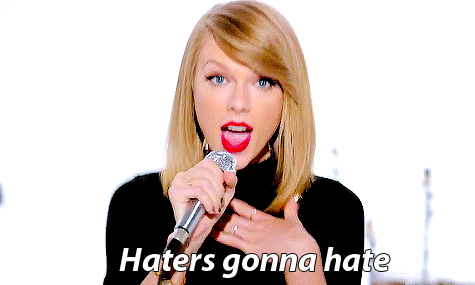No celebrity controversy seemed to define the late 2000s more than Kanye West interrupting Taylor Swift’s acceptance speech at the 2009 VMAs. For those who either live under a rock, and have no clue what transpired, or need a refresher, here’s what went down: as Swift received her award for best female video with “You Belong With Me,” a sunglass-donning West went up on stage shortly after. His words, which have been cemented into my memory, are as following: “Yo, Taylor, I’m really happy for you, I’mma let you finish, but Beyoncé had one of the best videos of all time! One of the best videos of all time!” The cameras cut to a surprised and puzzled Beyonce, whose reaction was arguably representative of how the rest of the audience and the world watching felt about the awkward interruption. Every talk show at the time weighed into the scandal and even then president Barack Obama issued some harsh words for West by calling him a “jackass.” In this situation, it was easy for the media and consumers alike to categorize the villain (West), victim (Swift), alongside the poor bystander who got thrusted into the situation (Beyonce, who offered Swift to redo her speech later that night when the former singer was accepting another award).
Perhaps the clear binary between who was in the wrong and who was in the right allowed the controversy to become so prevalent in pop culture discourse: without moral ambiguities, it is quick and easy to form an opinion on the matter. Even after West published a lengthy and frantic apology to Swift on his blog, before the days where Notes App apologies dominated social media platforms, the general public still condemned and ridiculed his behaviour. The famous were inclined to support Swift: singer Kelly Clarkson exclaimed “What happened to you as a child?? Did you not get hugged enough??” and Katy Perry tweeted “FUCK U KANYE. IT’S LIKE U STEPPED 0N A KITTEN.”
What Perry seemed not to acknowledge, however, was that stepping on a Kitten is a much more horrific and painful ordeal than the subsequent sympathy and praise that Swift received. She was consistently applauded for the maturity and ease in how she dealt with the situation and being characterized as the “Good Guy” isn’t too bad for one’s reputation. This is not to dismiss the media’s history of belittling and condescending Swift for merely singing about her life experiences and dating guys, as any other 20-something-year-old woman would. While this aspect of Taylor Swift’s media portrayal is drenched in misogyny, much of West’s defamation could be seen as being tainted with racism: Yolanda Sangweni at Essence Magazine wrote “if only West and Swift wouldn’t have played so perfectly into their roles: the innocent White girl and the supposedly menacing Black man.” This is not to imply that either artist strategically planned to invoke these stereotypes, but that the media’s responses to what are seemingly one-off pop culture events have their perspectives subconsciously influenced by tacit knowledge and prejudices of historically oppressive power dynamics.
It is worthy to note that a few years down the line, Taylor and Kanye happily made up. And then they fell apart again. In our more recent cultural timeline, what I like to refer to as “Famous-gate” occurred: in 2016, Kanye wrote the following lyrics about Swift in his 2015 song “Famous” from his album The Life of Pablo: “I feel like me and Taylor might still have sex / Why? I made that bitch famous.” The extravaganza involved leaked voicemails which allegedly reveal that Swift knew about the first part of the lyric and not the second, accompanied by the involvement of his at-the-time fiancé Kim Kardashian stepping her toes into the scandal. It was a confusing and perplexing mess between the music industry’s two biggest stars yet again. I won’t even attempt to summarize the whole controversy but Nate Jones at Vulture does an incredible job of thoroughly outlining their 2016 feud, so I’ll leave you with that. I contend that it is difficult to explain because the 2009 VMAs controversy simplistically provided us with the villain and victim binary, this time? Not so much. While some gleamed at the rehashing of their feud as fun celebrity gossip, others rolled their eyes at the pair publicly demonstrating this battle. As Taylor Swift responded to Kanye and Kim’s attacks on her with “I would very much like to be excluded from this narrative,” I imagine that the world at large felt mutual about being bombarded with details about the two fightings again.
As a big fan of both artists, I consistently return to thinking about West and Swift’s falling out, their reunion and then the two falling out again. I both celebrated the release of Donda and Swift announcing the rerelease of her 2012 album Red. While I refrain from becoming too engaged and invested in celebrity drama, I do pursue some wishful thinking in hoping that the two artists will repair their feud once again.
Another element of this particular pop culture moment that I find intriguing was the media’s hyperbolic and heightened reactions to the ordeal. Kanye West, who I believe was deserving of a more nuanced approach in 2009 due to losing his mother shortly before the award show, was crafted as an evil villain by celebrities, consumers and the President. It is also possible that West’s storming of the stage was a byproduct of his mental health struggles, but I will restrict myself from applying too much hindsight bias as mental illness was even more stigmatized over a decade ago than it is today. Overall, it is fascinating to examine not only the direct players in an iconic celebrity scandal but the reasons as to why the public has immortalized the moment itself.




